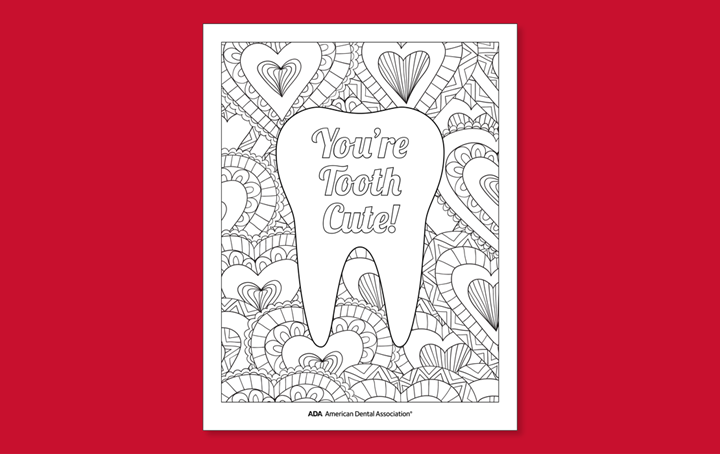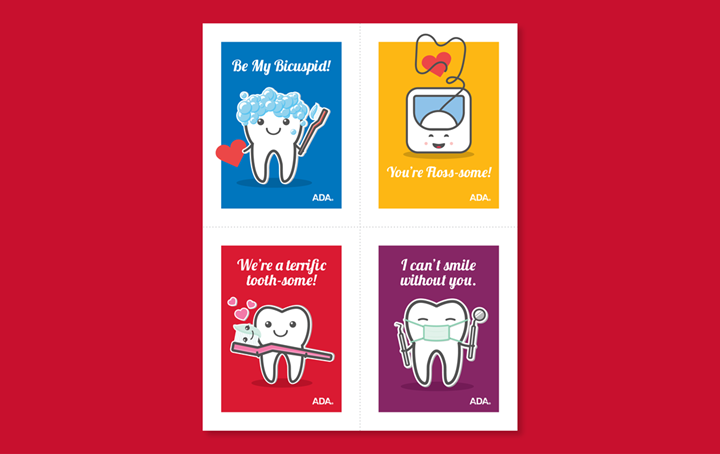Resources for lifelong dental health
Not sure how to choose a dentist? When should your child see a dentist? What can you expect at a visit?


Download printable resources and lesson plans to help children of all ages learn about oral health.
From welcoming the tooth fairy to keeping your smile safe on the field or court, these activities offer dental health lessons kids can use year-round.
From “floss-some” Valentines to scarily cute Halloween pumpkin carving stencils, we’ve got everything you need to bring good dental health habits into your holiday celebrations!
In February, the ADA celebrates National Children’s Dental Health Month (NCDHM) with resources to help parents, educators, community centers, dental professionals and dental societies engage kids in caring for their teeth. Explore colorful posters, flyers, postcards and tips for planning a successful event around this special awareness month.
Observed annually on March 20, the purpose of World Oral Health Day is “to empower people with the knowledge, tools and confidence to secure good oral health.” An initiative of FDI World Dental Federation, each World Oral Health Day launches a global campaign aimed at governments and policymakers, the healthcare community, schools and individuals to help reduce the burden of oral diseases and raise awareness of the importance of oral hygiene to overall well-being.
Smile Smarts! is a collection of four dental health curriculum plans for preschool through grade eight students offering flexible, modular lesson plans, support materials, hands-on classroom demonstrations, student activity sheets, and suggestions for future dental health activities.
Shining Smiles!
Shining Smiles! helps children ages 4 through 7 develop good dental health habits that can last a lifetime!
This program from the American Dental Association:
- Helps children ages 4 through 7 understand the importance of their teeth.
- Provides basic information, appropriate to their age and experience, about keeping teeth clean and healthy.
- Introduces the dentist as a friendly doctor who helps them take care of their teeth.
Start Teaching: Shining Smiles!
- Tiny Teeth Do Big Jobs (PDF)
- Keeping Teeth Bright and Healthy (PDF)
- A Visit to the Dentist (PDF)
A Lifetime of Healthy Smiles!
An engaging classroom lesson in good dental health habits for 2nd and 3rd grade students.
A Lifetime of Healthy Smiles! will help your students develop good dental hygiene habits that can last a lifetime! This program from the American Dental Association:
- Encourages students to think about and discuss the importance of their teeth.
- Provides information on good dental health appropriate to their age and experience.
- Reinforces dentists' instructions on properly caring for teeth.
Start Teaching: A Lifetime of Healthy Smiles!
- Teeth Are Terrific (PDF)
- Plaque Attack (PDF)
- You Have Power (PDF)
Teeth to Treasure!
A lively classroom lesson for 4th through 6th grade students showing how taking good care of our teeth is something each of us can do.
Teeth to Treasure! reinforces good dental hygiene habits and focuses on special activities and conditions that require extra "tooth attention." This program from the American Dental Association:
- Helps instill in students a sense of competence and responsibility for keeping their teeth clean and healthy.
- Provides information on good dental health and tooth protection appropriate to their age and lifestyle.
- Reinforces dentists' instructions on properly caring for teeth.
Start Teaching: Teeth to Treasure!
Watch Your Mouth!
A dynamic and thought-provoking classroom lesson for 7th and 8th grade students.
Watch Your Mouth! shows how informed teens can make smart choices to protect their teeth and health. Watch Your Mouth! also reinforces good dental hygiene habits and focuses on special activities and conditions that require extra "tooth attention." This program from the American Dental Association:
Helps instill in students a sense of competence and responsibility for caring for their teeth and mouth.
Provides accurate and timely information on behaviors that can cause dental health problems, such as mouth piercing and tobacco use.
Reinforces dentists' instructions on properly caring for teeth.
Associated Common Core ELA standards:
CCSS.ELA-LITERACY.L.8.4
CCSS.ELA-LITERACY.L.8.5.B
CCSS.ELA-LITERACY.L.8.6
CCSS.ELA-LITERACY.RI.3.1
CCSS.ELA-LITERACY.RI.8.4
Start Teaching: Watch Your Mouth!
Oral Health and You Presentation (PDF)
Crossword Puzzle (PDF)
Crossword Puzzle Answer Key (PDF)
Be Smart About Your Smile (PDF)
Going the Extra Smile (PDF)
Why are sugary drinks bad for teeth? And what’s the best way to make sure your teeth are clean? Teach kids how to better protect their teeth with these easy (and fun!) demonstrations.
Use these resources for interactive discussions with children about their oral health.
Easy-to-do Activities
The following activities from the National Children's Dental Health Month Program Planning Guide contain easy-to-do activities that can be done at any time. National Children's Dental Health Month takes place every February and strives to help children get a good start on a lifetime of healthy teeth and gums.
Dental Health Speakers
Contact the local dental society in your area to inquire about having a dental health month speaker come to your classroom.
Print and Video Resources
The American Dental Association produces a wide variety of educational materials, including pamphlets, posters, teaching packets and audiovisuals which can be viewed and purchased through the ADA Store.
Drinks Destroy Teeth
Free app for fun, interactive lessons about the effect of acid and sugar in popular drinks on teeth. Features videos, 3D mouth, vocabulary and a short quiz. Free curriculum resources are available on DrinksDestroyTeeth.org, an educational outreach program of the Indiana Dental Association.
Healthy habits
Name some things that you do to keep your body healthy. There are daily health habits that everyone needs to practice, such as eating a proper diet, exercising, bathing, and sleeping. Caring for your mouth is as important as caring for the rest of your body. Cleaning teeth and gums removes a sticky film of plaque. Plaque contains harmful bacteria that can cause tooth decay.
My Plate explanation
Show the USDA 'Choose My Plate' chart to children. Explain/review the food groups and why each is important for healthy bodies and teeth. List the five main food groups on a chalkboard or easel (grain, fruit, vegetable, dairy and protein). Have children discuss some of their favorite foods and write them under the appropriate group. Bring enough healthy snacks to share with the children and ask them to identify its food group. Free reproducible MyPlate sheets for children are available from the United States Department of Agriculture.
Primary teeth
Have children raise their hand if they had a tooth that fell out. Ask one or two children to describe what it feels like without the tooth. Discuss baby teeth. Some teeth are supposed to come out. They are called the "baby" teeth or "primary" teeth. After a baby tooth comes out, another tooth will come in. This new tooth must last for many, many years. You must take extra special care by brushing each day. (See also: Eruption charts: Primary Teeth and Permanent Teeth)
Tooth Function
Ask children to make a list of what foods can be eaten without teeth and what foods must be chewed. Without teeth you couldn't chew crunchy foods like carrots, nuts, or apples. Have children pronounce the alphabet and tell which sounds are made by using the teeth, tongue, and lips. If you didn't have any teeth, it wouldn't be easy to say teeth, toys, or toothbrush.
Have you had students express an interest in science? Let them know that a career in dentistry opens up a world of professional opportunities. Here are some resources for you to share to get them started!
Why choose dentistry?
There are many reasons to choose dentistry as a career. Dentistry offers an opportunity to make a difference in your patients’ health and well-being. It's a career that allows you a chance to be your own boss and own a dental practice. New exciting scientific breakthroughs in gene therapy and biotechnology offer dentists an opportunity to preserve their patients’ smiles and self-esteem.
Have questions such as:
- What's unique about dentistry?
- What does a dentist do?
- How to prepare for a career in dentistry?
- What career options are available?
Download the Dentistry Fact Sheet (PDF) and find answers.
Dentistry career options
Dentistry offers stimulating career options. In addition to private practice, excellent opportunities exist in teaching and research, careers with government agencies or in industry.
- Private Practice: Many dentists work either in solo private practice or in partnerships with other dentists. The majority of private practice dentists own their practices.
- Academic Dentistry: An academic dentistry career combines teaching, research, community service and patient care. Faculty members work in an intellectually stimulating and exciting academic environment. Career opportunities for academic dentists are excellent at this time. Additional information is available at the American Dental Education Association.
- Public Health Dentistry: This career focuses on community settings rather than private practice. Promoting dental health, developing health policy and preventing disease are the major roles of a public health dentist. Numerous opportunities exist in research and teaching within public health dentistry. The U.S. Public Health Service offers dentists an opportunity to provide dental care in unique cultural environments (e.g., an Indian Reservation, Coast Guard base, or Federal Prison).
- Research: Research careers offer opportunities to generate new knowledge and be on the cutting edge of scientific discoveries that ultimately impact patient care. Some of the latest research improving patient care includes lasers in surgery, implants to replace damaged bone and computerized X-rays. Many researchers are faculty at universities while others work in federal facilities, such as the National Institute for Dental and Craniofacial Research, and the National Institutes of Health; or in private industry. A career in research requires an advanced degree or additional training beyond the dental degree.
- International Health Care: Dentists provide services to populations abroad and work for such agencies as the World Health Organization (WHO), the United Nations Educational, Scientific and Cultural Organization (UNESCO), and the Food and Agricultural Organization of the United Nations (FAO). Many dentists volunteer to bring dentistry to aid people in developing countries.
- Hospital dentistry: Hospital dentists treat patients with medical conditions and disabilities alongside physician colleagues, often in operating rooms and emergency departments. Hospital dentists usually have a strong interest in medicine and collaborative care and have spent a year or more training in a hospital-based setting after dental school.
A career as a dental specialist
The majority of the 164,000 practicing dentists today are general practitioners. The remainder (about 20 percent) are dental specialists who limit their practices to one of the 12 ADA recognized dental specialties. The 12 dental specialties are: Dental Anesthesiology, Dental Public Health, Endodontics, Oral and Maxillofacial Pathology, Oral and Maxillofacial Radiology, Oral and Maxillofacial Surgery, Oral Medicine, Orofacial Pain, Orthodontics and Dentofacial Orthopedics, Pediatric Dentistry, Periodontics and Prosthodontics. In addition to four years of dental school, two or more additional years of dental specialty education are required.
Select a dental school
There are more than 60 dental schools in the United States accredited by the ADA's Commission on Dental Accreditation (CODA). Each program is rigorously evaluated for its content and quality. Typically, DDS/DMD programs take four years to complete with an additional year for dental specialties like Oral and Maxillofacial Surgery and Pediatric Dentistry.
Admission to dental school is highly competitive, but the application process has never been easier. Most U.S. dental schools accept a single online application through the American Association of Dental Schools Application Service (AADSAS).
Dental school admissions
Prerequisites
Students should contact individual dental schools for specific prerequisite information. Required courses generally include:
- 8 hours Biology with lab
- 8 hours Physics
- 8 hours English
- 8 hours General Chemistry with lab
- 8 hours Organic Chemistry with lab
Majoring in science is not a must, but completion of predental science requirements is necessary.
A college undergraduate degree is recommended in preparation for dental school. Most dental students have completed four years of college.
Dental Admissions Test (DAT)
Take the DAT at least a year prior to seeking admission to dental school. This computerized test measures general academic ability, comprehension of scientific information and perceptual ability. Completion of at least one year of college level courses in biology and general and organic chemistry is recommended before taking the DAT.
Applying
Admissions committees review credentials such as academic qualifications, the results from the Dental Admissions Test (DAT), grade point average (GPA), letters of recommendation, personal interviews and dental office shadowing experiences. Admission requirements can vary from school to school.
Most dental schools require personal interviews with candidates to assess qualities such as desire to help people, self-confidence, ability to meet challenges, ability to get along with people and capacity to work independently. The personal interview also provides an opportunity to ask about the school.
Apply for admission at least a year in advance of the planned enrollment date. Most dental schools participate in the Associated American Dental Schools Application Service (AADSAS). For a fee, students can subscribe to this service and complete a single application to apply to multiple dental schools. An online application to the schools participating in AADSAS is available here. The AADSAS toll-free number is 800-353-2237.
- Get the most current information on how to apply for the DAT
- View a list of ADA Commission-accredited U.S. and Canadian dental schools
Pay for dental school
Dental school, like other graduate and professional programs, is a significant investment. Over 90 percent of dental students take out loans to finance their education. Consult the ADA’s Financial Resources for Students for detailed information about financial planning and effective debt management.
Be a Dental Team Member
There is a great demand for dental team positions like dental hygienists, dental assistants and dental lab technicians. Hygienists and assistants interact closely with patients to ensure a high level of care, while dental lab technicians work behind-the-scenes, designing the dentures, crowns and braces used by dentists.
All dental team careers are well paid with flexible hours and the educational costs and commitment aren’t as significant as dental school. Learn more about accredited training programs.
